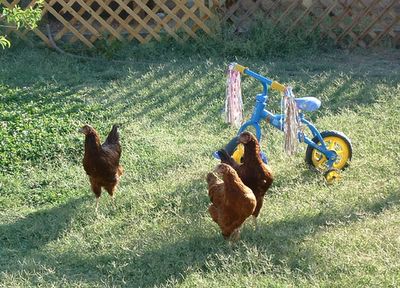Something ate Violet(probably the dog. again), so we're down to 3:
Zoinks! Senorita MacPhee and Babs turn out to be cockerels! After 2 weeks of croaky crowing at 5 AM, we trade them for an Ameracauna/Cuckoo Marin mix unconfusingly named --- Violet.
Then we drive 50 miles to pick up a Rhode Island and a Barred Rocks. But its a crazy place - there are about 100 chickens in a big pen all de-beaked! We never heard of such a thing. Horrid practice. We took them anyway, mostly because we were kind of in shock. If I had a clearer head I would've said 'No, thank you Mr. Crazy Chicken Debeaker.' Anyway, they're doing all right. One of them has a little trouble eating, so she's kind of thin. To keep the naming clear we just use the same names over again, so we're back up to 4 chickens: Senorita MacPhee, Babs, Kari, and Violet.









